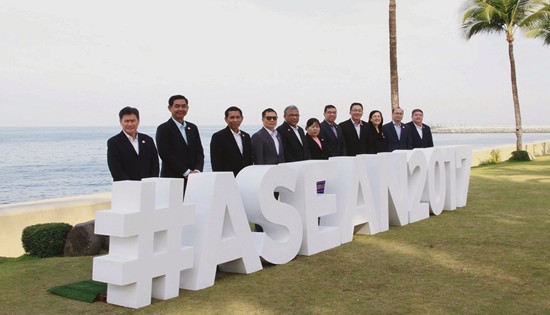PH’s economic
priority deliverables in ASEAN reaffirm inclusive growth agenda

By DTI-IDG-BITR
March 3, 2017
MAKATI CITY – The
31st High-Level Task Force on ASEAN Economic Integration (HLTF-EI)
convened on February 15-16 in Manila, gathering high-ranking ASEAN
trade officials to discuss the implementation of the ASEAN Economic
Community (AEC) Blueprint 2025.
HLTF-EI Chairperson and
Permanent Secretary of the Ministry of Foreign Affairs and Trade of
Brunei Darussalam Dato Lim Jock Hoi said that ASEAN needs to remain
strong and united as the region navigates and charts its course ahead
“collectively as ASEAN.”
Representing the
Philippines, Undersecretary for Industry Development and Managing Head
of the Board of Investment Ceferino Rodolfo laid down the Philippine
priority deliverables for 2017, highlighting the country’s agenda on
inclusiveness and innovation with a focus on increasing trade and
investments, integrating micro, small, and medium enterprises (MSMEs)
in the digital economy, and developing an innovation-driven economy.
“Inclusiveness should be
intrinsic to the ASEAN agenda. The AEC Blueprint 2025 development
framework will be most effective if it results from inclusive and open
multi-stakeholder participation, one that is informed by the
perspectives of people, especially the marginalized,” Undersecretary
Rodolfo said.
The Philippines is taking
the lead in seeking new policy interventions that are practical from
the MSME perspective. These are expected to contribute towards helping
MSMEs harness the opportunities presented by open and increasingly
integrated markets. These initiatives range from free trade and trade
facilitation, trade in services, investment, connectivity, and
innovation:
- Maximizing the benefits of
free trade agreements (Self-Certification for MSMEs, and Substantial
Conclusion of the Regional Comprehensive Economic Partnership [RCEP]);
- Fostering a more
facilitative and transparent trade in services regime and harnessing
the contribution and global competitiveness of the ASEAN services
sector (Conclusion of the ASEAN Trade in Services Agreement);
- Strengthening the
investment linkages between MSMEs and Multinational Enterprises or
MNEs (FAST Action Agenda on Investment, Inclusive Business, Women and
Youth Entrepreneurship);
- Enhancing intra-regional
connectivity and bolstering socio-economic growth in the regions
(Launch of the Davao-General Santos-Bitung route of the ASEAN Roll-on
Roll-of Network);
- Supporting an ecosystem of
entrepreneurship based on technology and innovation (ASEAN Declaration
on Innovation); and
- Introducing more
systematic and robust method for AEC compliance monitoring (ASEAN
Trade Facilitation Indicators, Review Mechanism for AEC).
Said priorities are in line
with the Duterte Administration’s 10-point socio-economic agenda. In
particular, these will leverage the global competitiveness of the
Philippines’ services sector in order to generate jobs and growth, as
well as bring development to the South through rural and value chain
development.
The Philippines also
delivered to HLTF-EI the collective statement of the ASEAN Civil
Society Conference/ASEAN Peoples’ Forum (ACSC/APF) Philippines
National Organizing Committee, reflecting the people’s aspirations for
an ASEAN that asserts peace and security, human rights,
democratization, and broad-based economic, social and ecological
justice.
Undersecretary Rodolfo
highlighted the potential of civil society organizations as strategic
and responsible partners in the process of ASEAN community-building,
given their knowledge and reach at the grassroots level and cohesive
international network.
Recommendations of the 31st
LTF-EI will be the focus of discussions at the 23rd ASEAN Economic
Ministers’ Retreat and Related Meetings to be held on March 8-10 in
Manila.
Composed of Trade Vice
Ministers from the ten ASEAN Member States (AMS), the HLTF-EI
functions as an advisory body to the economic ministers of the AMS,
ensuring that all 10 AMS are on-track and on-time with the plans and
programs intended to realize regional economic integration and achieve
the vision of an AEC.
The AEC Blueprint was
crafted to further advance ASEAN economic integration, envisioning a
community characterized by the following: a) a highly integrated and
cohesive economy; b) a competitive, innovative, and dynamic ASEAN; c)
enhanced connectivity and sectoral cooperation; d) a resilient,
inclusive, and people-oriented, people-centred ASEAN; and e) a global
ASEAN.
ASEAN economies are expected
to hold up reasonably well amidst the slowing of global growth, and
the uncertain and shifting geo-political and economic landscape.
Forecasts from the Asian
Development Bank and the International Monetary Fund place the region
as the most dynamic part of the world with strong economic outlook for
2017 at 4.6% to 4.9% of GDP growth rate, vis-à-vis the 3.4% projected
for the growth global GDP. The Philippines leads the region with a
growth forecast of 6.8% for 2017.